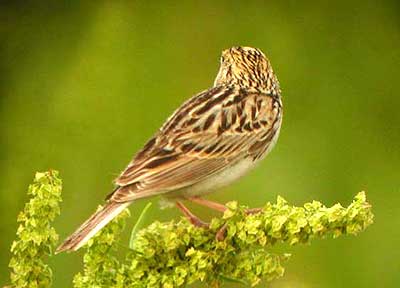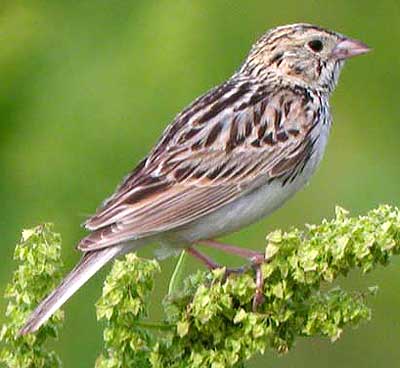
Photo © 2002 Alvaro Jaramillo
All rights reserved.

 Photo © 2002 Alvaro Jaramillo All rights reserved. |
 |
Thanks again for the thoughtful comments. I have added an additional photo. The bird on the right is the same individual. Note the separated black spot not connecting to the eye and separated dark border to the rear of the ear-coverts. This impression of black spots separated from the eye is a good character which helps distinguish Baird's Sparrow from the rather similar juvenile Savannah Sparrow.
Al Jaramillo provided the following interesting comments:
I think some may clue in to the head color and get this right away, other folks may see those white tail feathers and get confused. In fact white outer edges to the rectrices is the norm in this species. What I noticed on this Baird's Sparrows and all good photos I could get of adults (does not work on juveniles I think) is the pattern of the tertials: S9(T3) is broad and square tipped, S8 (T2) is broad at the base with a cinnamon fringe and then quickly tapers on the outer 1/3d, showing a thin whitish fringe; while S7 (T1) tapers dramatically in a similar way but much closer to the base of the feather. The overall pattern appears to be there on other photos I have seen, but it is drastically altered by how worn the feathers are. I would guess that when fresh the tertials may actually be of a "regular" shape but that pale edges that are wider towards the tip wear away and leave this pattern later? Note that this individual does not look all that worn for a mid July bird, perhaps this is because they spend so much time hiding in the shelter of the grass? Another bit to look at is the greater coverts which show this distinctive pattern of being largely blackish with cleanly demarcated cinnamon (maybe that is not the appropriate color to call them) tips. Looking at photos of other Ammodramus species it looks like other species show distinctive shapes or patterns on the tertials and greater coverts. Grasshoppers are very complex in pattern, with a dark splotch at the base of the tertials, but they do narrow down similarly to the Baird's. The greater coverts are gray-brown with distinct blackish subterminal areas and then a white tip/fringe. Henslow's have a simple pattern of black tertials and greater coverts with thin whitish or buff fringes, but the feathers themselves are distinctly round-tipped, not squared off or tapered. LeConte's has the oddest tertials, showing a double-rounded ("W" pattern) to their tips, the whitish edging is distinctive. Greater coverts are like Henslow's but with broader buff edging, obscuring the dark centers. The Sharp-tails and Seasides are more standard, much like other sparrows. In any case these odd tertials/greater covert patterns caught my attention. Feel free to use any of this in your discussion, and to poke holes in the hypothesis. I am sure there is more variation that I can make out by looking at a few photos, it would be neat to check this out on specimens.
Color perception has been a chronic problem in assessing photographic images on the web. This problem is compounded by the wide variety of hardware and software used to view these images. Please adjust your video to the highest possible number of colors. My logs show that over 25% of visitors view these pages with only 256 colors (8 bit). Sixteen bit (high color) is minimum and 24 bit (true color) desirable. Also you may wish to calibrate your monitor against a color standard and ensure that brightness and contrast are set correctly.